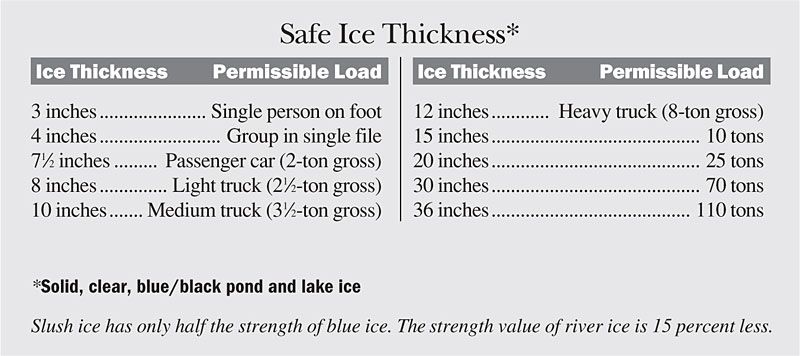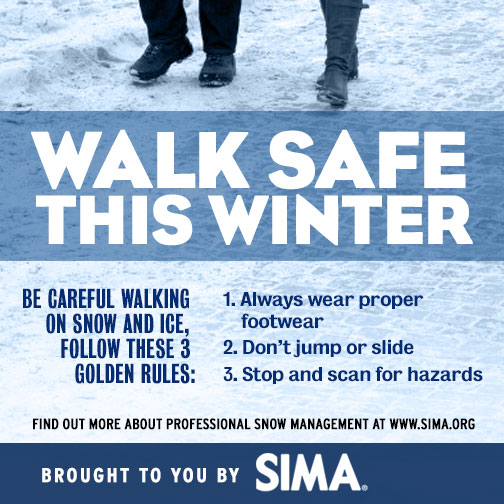The best way to get to the ice is with your UTV. It can haul a small ice fishing shed and your fishing or ice skating gear without worrying about getting stuck. Enjoy ice skating and ice fishing on that pond or lake that’s only accessible by snow machines or other off-road vehicles with these tips:
Before you head out, check the snow conditions and OHV trail and road closures. Snow conditions will determine whether you need additional accessories such as tracks for your UTV. Making sure the trails are open for your UTV will prevent disappointment if they are closed to all vehicles or if they are open only to snow machines.
Additionally, you need to check for ice thickness. If the ice is clear and it’s under 4 inches deep, it’s not safe. If it’s white snow ice and under 8 inches thick, it’s not safe. When checking ice, if it’s white snow ice, double the thicknesses for safety. Safe thicknesses for different vehicles include:
If you are ever unsure, stay off the ice.
Always measure the thickness of the ice at least every 150 feet. Ice could be 12 inches thick in one place and just a few yards away, it could be less than 4 inches thick. You can use an ice auger, chisel or a cordless drill to make a hole in the ice. Once the hole is drilled, then hook the end of the tape measure to the bottom of the ice to take the measurement.
If you are driving a vehicle on the ice, be sure to stay where you’ve checked. Drive slowly on the ice and never leave your vehicle parked in one place for more than two hours. To see if the ice is sinking near your vehicle, drill a hole next to the vehicle. If you see the water coming out of the hole onto the top of the ice, the ice is sinking—move your vehicle.
When you take your UTV out, be sure to pack accordingly. You never know when you might end up stranded, even in a UTV. Be sure to bring the following:
If you have space, a blanket for each person and a tarp are good additions. If you do have to stay overnight the tarp could be used as a tent and the blankets will help keep you warm. Also, bring kindling and paper to help get a fire started.
Always have the proper accessories and apparel to keep yourself safe while you’re out on the ice. The best way to stay warm is to layer your clothing.
The best way to stay warm is to layer your clothing.
The first layer should be some type of synthetic-blend long underwear top and bottom. This should be loose-fitting and comfortable. Wear your regular clothes over this layer. Your feet should be covered with loose-fitting wool socks and your boots should be waterproof and insulated.
The outer layer should be a warm jacket and insulated pants. For your extra change of clothes, you should bring all of these layers. Additionally, make sure you have a face mask and an approved helmet. The face mask will protect your face from the cold and may be worn under the helmet.
For a warmer, more enjoyable riding experience, equip your UTV with some accessory upgrades:
You could use a full cab or add a soft roof with a windshield, which will keep a lot of the wind off you as you’re driving. If you completely enclose the UTV, adding a cab heater will really keep you warm.
If you completely enclose the UTV, adding a cab heater will really keep you warm.
A snow plow for your UTV not only allows you to plow your driveway, but it will let you plow the ice if it has a layer of snow on it. You shouldn’t use it to plow the trails as most trails are maintained. Your plow could wreck the snowpack on the trail.
Tire chains help if you are stuck on a hill or in an area where there may be snow and water. While you could winch yourself out, the winch cable only goes so far. Tire chains will give you enough traction to get yourself out of many spots.
When choosing a UTV, keep the use in mind. If you plan on using it during the winter, you need a powerful vehicle that is reliable and has good ground clearance to drive through deep snow. The 2019 Polaris Industries Ranger Crew XP 1000 EPS NorthStar HVAC Edition features a ProStar engine that makes 82 horsepower. It also has HVAC to make riding in the winter much more comfortable. The heat will also serve to warm you up while ice fishing so you can spend more time on the ice.
This Polaris comes standard with the Ranger Pro Shield cab system and factory installed HVAC system. With a 13-inch ground clearance, you’ll be able to hit most trails or even go off the trails in deeper snow. This model tows up to 2,500 pounds, so you can easily haul an ice shack to the lake. It uses a standard 2-inch receiver to haul a small trailer.
Check out our full inventory of UTVS and accessories at Tousley Motorsports for you and your vehicle to stay safe while enjoying winter activities.
We know how well ATVs handle in rugged conditions, but can they work effectively in winter, and are they any good on ice?
ATVs are good for driving on ice as long as they are compact, lightweight, and the ice is thick enough to support the weight of the machine. Equip an ATV with winter tires and tire chains, brake gently, and accelerate with ease to get good performance from an ATV on ice.
We have previously handled ATVs on ice to test this same question. Some ATVs work better than others, and it can be dangerous when the ice needs to be more durable. We’ll explain exactly how to drive an ATV on ice correctly below.
Some ATVs work better than others, and it can be dangerous when the ice needs to be more durable. We’ll explain exactly how to drive an ATV on ice correctly below.
Yes, ATVs are good on ice. You need to ensure you have enough clearance between the ground and the tires of your ATV so that it doesn't get stuck when you go over a patch of ice.
ATVs tend to have powerful engines, and they are used for various purposes, such as farming, construction, and transportation. However, they are the perfect winter vehicles for snow plowing and ice fishing.
The weight of an ATV has a lot to do with how well it will perform in snow and ice. Lighter ATVs will drive on ice without causing too much pressure, so it can be safe.
Overall, ATVs are good on ice because they are designed with specially-engineered treads that grip the ice instead of sliding. They also have a lower center of gravity, which helps them maintain balance and stability on slippery surfaces.
Riding ATVs on ice and snow requires careful attention to safety. Knowing the risks and doing everything you can to minimize them is essential.
The following tips can help keep you safe while riding your ATV on ice.
The first thing to do is to ensure that you wear the proper clothing. This includes a helmet, gloves, and boots.
Be sure to have the appropriate safety gear for the type of terrain you will be riding on. This will make handling the vehicle with care easier, especially on a more fragile surface like ice.
Tire snow chains can be used on ATVs when driving on ice. They are a more effective way to drive on icy surfaces and can provide additional traction.
When an ATV is driven on ice, it can slip easily because the tires lose their grip. Tire snow chains help to provide extra traction and prevent slipping by wrapping around the tires.
We highly recommend trying these, especially when using traditional tires without tracks. This eliminates the risk of spinning out or getting stuck.
Tire snow chains are also a must-have for people living in areas that experience heavy snowfall throughout the winter season.
Before you go out to drive your ATV on the ice, inspect the tires. Make sure they are inflated and that there are no cracks or tears.
You should also make sure that the machine is in good working order before heading out. This includes checking the fluid levels, tire pressure, spark plugs, etc.
Winterizing your ATV is relatively easy and extremely important for safety purposes.
When driving on ice, it is important to have tires that are made for the icy conditions. Snow-grade tires are designed to have a better grip on slippery surfaces.
They also have a wider tread for increased traction. This is helpful to keep the ride stable with no handling issues.
Tires with tracks will improve traction by keeping the vehicle from sliding sideways, which is especially helpful when driving on ice. Expect improved stopping distances and more accurate acceleration too.
Braking gently is also important, or the tires will likely slide, and stopping will become more difficult. This is unsafe, and losing control of the ATV on ice can be scary.
When you come to a stop, put your weight back on your footrests, not your heels, and try to avoid putting too much weight on one side of the ATV at a time.
Make sure you have a good grip on the handles and stay away from puddles and water while braking. If you start sliding, don't panic, especially if the area is open.
When accelerating on an ATV on ice or snow, it is important to be careful to avoid accelerating too aggressively. This can cause the ATV to lose traction and spin, leading to a loss of speed and control.
Accelerate slowly and gently when you first start to drive over the surface of the ice. This will help you avoid slipping or the tires spinning excessively.
This will help you avoid slipping or the tires spinning excessively.
In general, driving slower on ice is also recommended because stopping is more challenging.
An ATV is a type of light utility vehicle. It is designed to be able to operate on snow, ice, and terrain that would not be suitable for a car.
The thickness of the ice required to support an ATV varies depending on the size and weight of the vehicle. The minimum thickness that would allow an ATV to travel safely is approximately three to four inches thick.
It’s estimated that four inches of ice can support 200-250 pounds before cracking. This gives enough support for lighter, smaller ATV’s.
Any larger utility ATVs might be close to or above this weight limit, making them riskier to ride on ice unless it's closer to six or seven inches thick.
When ice is thicker than seven inches, it's safe to drive on. Typically, seven to ten inches can even support smaller cars.
When driving on ice, it is important to know how thick the ice is to drive safely. There are many ways to tell if the ice is thick enough for driving.
The easiest method is to analyze the color and shade of the frozen ice. Typically, clear light blue ice is the strongest and thickest ice, with a minimum thickness of at least six inches in most cases.
This would make it perfectly safe to drive with most ATVs. However, if the ice looks much darker, it’s considered too thin and dangerous even to walk across, nevermind drive an ATV on it.
It’s also possible to see white ice. We don’t recommend driving on white ice because it's still too thin and weak to support an ATV.
It is safe to drive an ATV on ice, but it is important to use caution. You should only go out if you are sure of the conditions. Don’t try to drive on it if the ice looks too thin or shaky to drive across.
You should only go out if you are sure of the conditions. Don’t try to drive on it if the ice looks too thin or shaky to drive across.
If you consider driving an ATV on ice, you must be confident in your vehicle and its abilities. It is also important that you understand the limitations of your vehicle and the risks involved with driving on ice.
Keep your ATV in good shape so it will not break down while driving over rough terrain. Always wear a helmet and other safety gear when driving an ATV on ice.
Only attempt to drive on ice with proper training. It’s not easy the first time, so getting experience is recommended. This helps you spot whether the ice is thick enough and how to handle the vehicle on slippery surfaces.
Maintaining a balance between the speed and traction of an ATV is vital. If you accelerate too aggressively, it will cause the wheels to spin with less traction, and you will be more likely to lose control of the vehicle.
The best-sized ATV will depend on a few factors, like the age and experience of the rider. We recommend a 400cc ATV because it is light enough while still providing enough power to drive with stability.
We recommend a 400cc ATV because it is light enough while still providing enough power to drive with stability.
It’s also better to use an ATV with wider tires for improved traction. However, the problem with a 400cc ATV is average weight close to 500 pounds.
This can be an issue if the ice needs to be thicker. Assuming the ice is only 4-5 inches thick, we recommend a 200cc ATV to remain safe while avoiding too much weight on the fragile surface.

https://ria.ru/20190328/1552174694.html Ice thickness is safe for people and cars less than 30... RIA Novosti, 03.03.2020
2019-03-28T03:13
2019-03-28T03:13
2020-03-03T13:51
society
russia
/[oghtml:head=
]/@content
/html/head/meta[@name='og:description']/@content
https://cdnn21.img.ria.ru/images/151251/92/1512519252_0:83:2200 :1321_1920x0_80_0_0_f860cf0f610280a5aa2302f362377474.jpg
MOSCOW, March 28 - RIA Novosti. The safe thickness of ice that can withstand one person is at least seven centimeters, cars need ice at least 30 centimeters thick to pass, according to the website of the GUMCHS in the Moscow Region. Rescuers recommend organizing a pedestrian crossing through a reservoir with an ice cover of at least 15 centimeters, for cars the minimum ice thickness should be 30 centimeters. The agency notes that snow falling on the ice slows down the formation of an ice crust, so the ice under the snow is less strong. Thin ice is most often found in places with fast currents, deep places open to the wind, over shady and peaty bottoms, near marshy shores, in places where underwater springs come out, under bridges and in narrow channels, as well as near places where water is discharged from enterprises. Also, the ice is less strong in places where reeds and other aquatic plants grow. Rescuers advise crossing a frozen body of water on skis, while the bindings must be unfastened, and hands should not be put into the loops of ski poles, so that if necessary, quickly throw off all the equipment. If you have a backpack, it should be carried on one shoulder so that you can quickly get rid of it in case of danger.
The agency notes that snow falling on the ice slows down the formation of an ice crust, so the ice under the snow is less strong. Thin ice is most often found in places with fast currents, deep places open to the wind, over shady and peaty bottoms, near marshy shores, in places where underwater springs come out, under bridges and in narrow channels, as well as near places where water is discharged from enterprises. Also, the ice is less strong in places where reeds and other aquatic plants grow. Rescuers advise crossing a frozen body of water on skis, while the bindings must be unfastened, and hands should not be put into the loops of ski poles, so that if necessary, quickly throw off all the equipment. If you have a backpack, it should be carried on one shoulder so that you can quickly get rid of it in case of danger.
https://realty.ria.ru/20190321/1551982166.html
Russia
RIA Novosti
1
5
4.7
9000
495 6455 -6601
Federal State Unitary Enterprise MIA “Russia Today”
https: //xn---C1acbl2abdlkab1og. xn--p1ai/Awards/
xn--p1ai/Awards/
2019
RIA Novosti
5
9000 4.7 9000 9000 9000 9000 90007 495 645-6601
FSUE MIA Rossiya Segodnya
https://xn--c1acbl2abdlkab1og.xn--p1ai/awards/
ABOUT/COPYRIGHT.HTML
https: //xn---c1acbl2abdlkab1og.xn--p1ai/
RIA Novosti
1
5
4.0002 9000 9000
4
,0002 645-6601
FSUE MIA Rossiya Segodnya
https://xn--c1acbl2abdlkab1og.xn--p1ai/awards/
1920
1080
true
1920
1440
true
https://cdnn21.img.ria.ru/images/151251/92/1512519252_37:0:2024:1490_1920x0_80_0_0_09c90ae271b7aff6ff670b70a8222343.jpg
1920
1920
True
RIA Novosti
1
5
4.7
96
RIA Novosti
1
5
4.7
96 9000
Internet-group@rian. ru
ru
7 495 64 64 64 64 64 64 64 64 64 64 64 64 64 64 64 64 64 64 64 64 64 64 64 64 64 64 64 64 64 64 64 64 64 64 64 64 64 64 64 64 64 64 64 64 64 64 64 64 64 64 64 64 64 64 64 64 64 64 64 64 64A
FSUE MIA Rossiya Segodnya
https://xn--c1acbl2abdlkab1og.xn--p1ai/awards/
Society, Russia
Society, Russia
MOSCOW, March 28 - RIA Novosti. The safe thickness of ice that can withstand one person is at least seven centimeters, cars need ice at least 30 centimeters thick to pass, according to the website of the GUMCHS for the Moscow Region.
Rescuers recommend organizing a pedestrian crossing through the reservoir with an ice cover of at least 15 centimeters, for cars the minimum ice thickness should be 30 centimeters.
The agency notes that snow falling on ice slows down the formation of an ice crust, so the ice under the snow is less strong. Thin ice is most often found in places with fast currents, deep places open to the wind, over shady and peaty bottoms, near marshy shores, in places where underwater springs come out, under bridges and in narrow channels, as well as near places where water is discharged from enterprises. Also, the ice is less strong in places where reeds and other aquatic plants grow.
Also, the ice is less strong in places where reeds and other aquatic plants grow.
Rescuers advise to cross the frozen pond on skis, while the bindings should be unfastened, and hands should not be put into the loops of ski poles, so that if necessary, quickly throw off all the equipment. If you have a backpack, it should be carried on one shoulder so that you can quickly get rid of it in case of danger.
Theater on ice, or a play of city services that can save lives
March 21, 2019, 11:18
It's winter outside and we, as always, can't sit at home. Why not ride a trusty quad bike and have fun and crazy winter rides on snow and ice? Certainly! There is no reason to lock the quad in the garage with the onset of frost and snowstorms. This technique is specially designed to please us at any time of the year and in any weather.
This technique is specially designed to please us at any time of the year and in any weather.
A powerful engine, a stable balanced base, toothy off-road tires ─ all this allows the ATV to move confidently both on icy and snowy surfaces.
But of course, you need to remember that the operation of an ATV in winter conditions has its own characteristics. Special training is needed for both the technique and the rider. We will talk about what features of the snow season should be taken into account in this article.
Oil change. It's no news to anyone that the correct operation of any engine depends on the right engine oil. When choosing an oil, first of all, the recommendations of the equipment manufacturer, operating conditions and, of course, the season are taken into account. Motor oil, like any liquid, tends to change density and viscosity with temperature. If an oil with a viscosity index of 10W40 is optimal for hot summer weather, then at low temperatures this viscosity is excessive, which can adversely affect engine operation and even damage it. When operating the ATV in winter, it is better to use engine oil with a viscosity index of 5W30 or lower. In any case, it is better to entrust the selection of lubricants to professionals and contact an authorized service.
When operating the ATV in winter, it is better to use engine oil with a viscosity index of 5W30 or lower. In any case, it is better to entrust the selection of lubricants to professionals and contact an authorized service.
 0 atmospheres. For winter penetrations, we advise you to release pressure to values of 0.5 - 0.7 atmospheres. And do not rush to immediately go off-road. Do a couple of test drives in the immediate area. If the result is not impressive and confident movement on the snow could not be achieved even with lowered wheels, we advise you to think about taking more drastic measures. For example, you can purchase snow chains for your ATV or think about installing wheel extensions, tracks or other special tools. In order not to get into an unpleasant situation, you must always soberly assess your capabilities. Although the ATV is designed to drive on snow in winter, its possibilities are not unlimited. Even if you have a four-wheel drive ATV, do not climb too far into the wilds if the snow depth exceeds 40 cm. And it is better not to ride alone, so as not to be alone in the winter forest with a frozen ATV.
0 atmospheres. For winter penetrations, we advise you to release pressure to values of 0.5 - 0.7 atmospheres. And do not rush to immediately go off-road. Do a couple of test drives in the immediate area. If the result is not impressive and confident movement on the snow could not be achieved even with lowered wheels, we advise you to think about taking more drastic measures. For example, you can purchase snow chains for your ATV or think about installing wheel extensions, tracks or other special tools. In order not to get into an unpleasant situation, you must always soberly assess your capabilities. Although the ATV is designed to drive on snow in winter, its possibilities are not unlimited. Even if you have a four-wheel drive ATV, do not climb too far into the wilds if the snow depth exceeds 40 cm. And it is better not to ride alone, so as not to be alone in the winter forest with a frozen ATV.  It is hard to imagine that after such adventures, moisture did not get into the components and mechanisms of the ATV. And as every person who attended school physics lessons knows, water crystallizes at sub-zero temperatures and increases its volume. It destroys all the cavities into which it has penetrated. If water enters the cooling system circuit, you can easily get problems in the form of cracks in the radiator or in the engine housing. The same applies to other mechanisms, such as the brake system, gearboxes, etc. Before the start of the winter season, inspect all systems and components of the ATV, make sure that all connections are tight. Change antifreeze and brake fluid. This will help to avoid sudden breakdowns and costly repairs in the winter season. It is also recommended to add a chemical dehumidifier to the fuel tank in winter to prevent clogging of the fuel system. Treat rubber elements of the chassis and transmission, cables, ignition lock cylinder with silicone grease.
It is hard to imagine that after such adventures, moisture did not get into the components and mechanisms of the ATV. And as every person who attended school physics lessons knows, water crystallizes at sub-zero temperatures and increases its volume. It destroys all the cavities into which it has penetrated. If water enters the cooling system circuit, you can easily get problems in the form of cracks in the radiator or in the engine housing. The same applies to other mechanisms, such as the brake system, gearboxes, etc. Before the start of the winter season, inspect all systems and components of the ATV, make sure that all connections are tight. Change antifreeze and brake fluid. This will help to avoid sudden breakdowns and costly repairs in the winter season. It is also recommended to add a chemical dehumidifier to the fuel tank in winter to prevent clogging of the fuel system. Treat rubber elements of the chassis and transmission, cables, ignition lock cylinder with silicone grease.
Battery and electrical. Riding an ATV in winter requires careful attention to all components and systems, including electrics. If you are going to operate the ATV in the winter, pay special attention to the condition of the battery in preparation for the season. At extremely low temperatures, the battery loses its charge much faster than in summer. Before your first winter drive, fully charge the battery. During operation in the cold season, regularly check the charge level, it should be in the range of 12.6 - 13.1 V. Not all models of ATVs have an electric starter duplicated by a manual one in case of unforeseen circumstances. By paying attention to this issue, you will not be left in the cold winter forest next to a stationary ATV with a completely dead battery. Check and clean all contacts, treat them with special grease. This will avoid moisture ingress, short circuits and malfunctions.
Take care of your comfort. The modern tuning industry offers many technical solutions to improve the level of convenience and comfort during the winter operation of an ATV. To keep your hands warm, install oversized winter protection mugs or insulated muffs, as well as electric heated handles. The windshield of the increased area will help to hide from the oncoming flow of icy air. But do not forget that it will increase windage and worsen aerodynamics, and as a result, speed characteristics.
The modern tuning industry offers many technical solutions to improve the level of convenience and comfort during the winter operation of an ATV. To keep your hands warm, install oversized winter protection mugs or insulated muffs, as well as electric heated handles. The windshield of the increased area will help to hide from the oncoming flow of icy air. But do not forget that it will increase windage and worsen aerodynamics, and as a result, speed characteristics.
Active and dynamic quad rides on an ATV in winter are seriously different from a leisurely walk on a frosty evening. In this case, the usual advice to “dress warm” is clearly not enough. If you don't get the right seasonal gear, the oncoming icy airflow can quickly lead to hypothermia and even frostbite. Also, do not forget that anything can happen when traveling off-road and you should always prepare for the fact that you will have to spend much more time in the cold than planned.
 Due to the warm lining, they are much more comfortable for the rider, and most importantly, their visors are protected from condensation and fogging. This allows you to always maintain a high-quality overview, which is important for safety. If you opted for a summer helmet, buy winter glasses with a double lens and anti-fog. Do not save on your own safety and you can avoid a lot of trouble. And in order to capture a mind-blowing video of a quad bike ride on ice and snow, equip your helmet with a mount for an action camera.
Due to the warm lining, they are much more comfortable for the rider, and most importantly, their visors are protected from condensation and fogging. This allows you to always maintain a high-quality overview, which is important for safety. If you opted for a summer helmet, buy winter glasses with a double lens and anti-fog. Do not save on your own safety and you can avoid a lot of trouble. And in order to capture a mind-blowing video of a quad bike ride on ice and snow, equip your helmet with a mount for an action camera.
What you need to take with you on the road. You never know in advance what adventures await you on the roads and when exactly you will return home. You need to be prepared for anything and have with you the necessary supply of food, water and the simplest items for survival in the wild. You will definitely need delicious sandwiches, fragrant hot tea in a thermos, a flashlight and matches. It will not be superfluous to fully charge the phone and, if possible, put another one in your backpack, as well as take a charged power bank on the road.